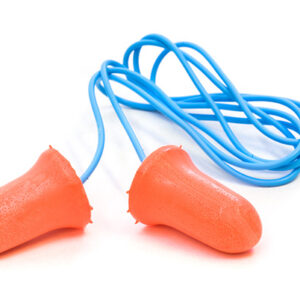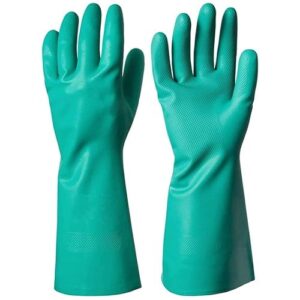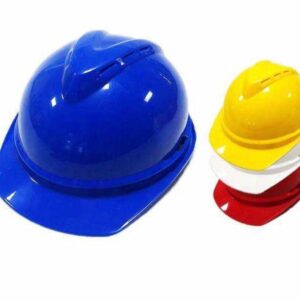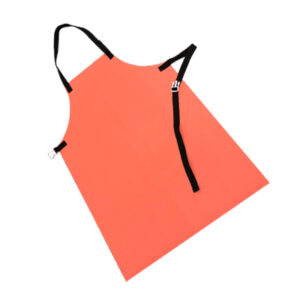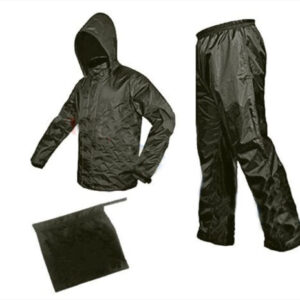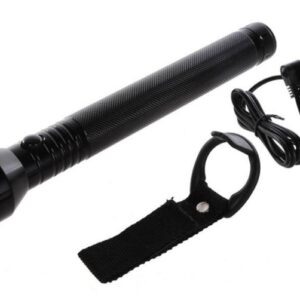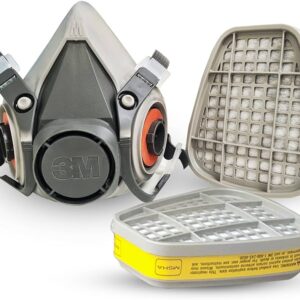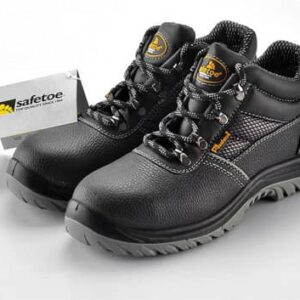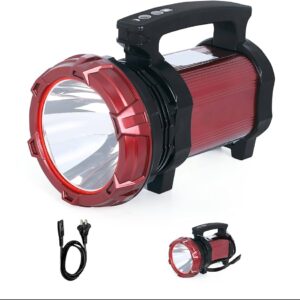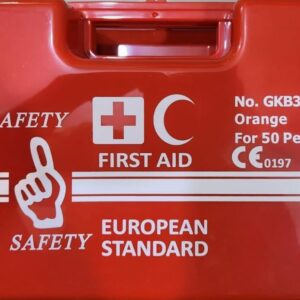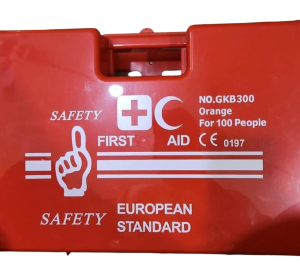-
EAR PLUG
EAR PLUG are small, cylindrical devices designed to be inserted into the ear canal to reduce the transmission of sound waves from the external environment to the inner ear. They are typically made from soft materials such as foam, silicone, or wax, which conform to the shape of the ear canal for a secure and comfortable fit. Ear plugs come in various shapes and sizes to accommodate different ear canal sizes and preferences. Some are disposable, while others are reusable and can be cleaned for extended use.
The effectiveness of ear plugs in reducing noise depends on their design and material. Foam ear plugs, for example, expand after insertion to create a snug seal, blocking out a significant amount of external noise. Silicone ear plugs are moldable and can be shaped to fit the contours of the ear canal, offering customizable comfort and noise reduction. Custom-molded ear plugs are individually crafted to precisely fit the wearer’s ear, providing maximum effectiveness and comfort tailored to specific needs.
Importance of Ear Plugs
The importance of ear plugs centers around their role in protecting hearing health and enhancing comfort in noisy environments. Key reasons why ear plugs are essential include:
- Hearing Protection: Ear plugs serve as a crucial defense against noise-induced hearing loss (NIHL), a common and preventable form of hearing impairment caused by exposure to loud noises over time. By reducing the intensity of sound reaching the ear canal, ear plugs help preserve auditory function and minimize the risk of permanent damage.
- Occupational Safety: In industrial settings, construction sites, factories, and other workplaces with high noise levels, ear plugs are mandated to comply with occupational safety regulations. They safeguard workers from prolonged exposure to hazardous noise levels, promoting a safer and healthier work environment.
- Enhanced Sleep Quality: For individuals sensitive to noise disruptions during sleep, such as snoring, traffic, or neighborhood sounds, ear plugs can significantly improve sleep quality. By reducing ambient noise, ear plugs facilitate uninterrupted rest and contribute to overall well-being.
- Concentration and Focus: In noisy environments such as offices, classrooms, or study areas, ear plugs help minimize distractions and background noise. This allows individuals to maintain concentration, enhance productivity, and improve learning outcomes.
- Comfort in Travel and Recreation: During air travel, road trips, or recreational activities in noisy settings (e.g., concerts, sporting events), ear plugs provide comfort by attenuating loud sounds. They enable travelers and participants to enjoy activities without discomfort or sensory overload.
Advantages of Ear Plugs
The advantages of using ear plugs include:
- Effective Noise Reduction: Ear plugs significantly reduce the intensity of noise entering the ear canal, offering immediate and reliable protection against loud sounds.
- Portability and Convenience: Ear plugs are lightweight, compact, and easily portable, making them convenient for use in various settings and activities where noise reduction is necessary.
- Customization Options: Depending on individual preferences and needs, ear plugs are available in different sizes, shapes, and materials. Custom-molded ear plugs provide personalized fit and enhanced comfort for extended wear.
- Affordability: Ear plugs are cost-effective compared to other forms of hearing protection, making them accessible for regular use by individuals and organizations alike.
- Hygienic and Reusable: Many ear plugs are designed for multiple uses and can be cleaned and stored for extended durability, offering economical and sustainable hearing protection solutions.
Uses of Ear Plugs
Ear plugs are employed across various contexts and environments to provide effective noise reduction and hearing protection:
- Workplace Safety: Essential in industrial settings, construction sites, manufacturing facilities, and noisy workplaces to comply with occupational health and safety standards and protect workers from noise-induced hearing damage.
- Sleeping: Used to enhance sleep quality by reducing disturbances from snoring, traffic noise, or other nighttime sounds, promoting restful and uninterrupted sleep.
- Travel: During air travel, ear plugs mitigate discomfort from engine noise and cabin pressure changes, enhancing comfort during flights. They are also beneficial for road trips to reduce road and vehicle noise.
- Concerts and Events: Attendees and performers use ear plugs to attenuate loud music and amplified sound levels, protecting hearing while enjoying live performances and events.
- Water Activities: Waterproof ear plugs prevent water from entering the ear canal during swimming, showering, or water sports, reducing the risk of swimmer’s ear and other ear infections.
Conclusion
In conclusion, ear plugs play a vital role in safeguarding hearing health, enhancing comfort, and minimizing noise-related disruptions in diverse environments and activities. Their effectiveness in reducing noise exposure, portability, customization options, affordability, and versatility make them indispensable for individuals seeking to protect their auditory well-being and improve quality of life. By incorporating ear plugs into daily routines, whether for work, leisure, travel, or sleep, individuals can mitigate the risks associated with excessive noise exposure and enjoy a healthier auditory experience. Regular use of ear plugs not only preserves hearing abilities but also promotes overall well-being by ensuring adequate rest, concentration, and comfort in noisy environments. Therefore, ear plugs represent a practical and valuable solution for individuals and organizations committed to maintaining hearing health and safety in today’s noisy world.
₵13.00EAR PLUG
₵13.00 -
WHISTLE
A whistle is a compact, handheld device designed to produce a high-pitched, penetrating sound when blown into. Typically made from durable materials like metal or plastic, whistles are engineered with a small chamber and an aperture that focuses airflow to create a distinct tone. The design often includes a pea or ball inside the chamber that vibrates when air passes through, amplifying the sound and ensuring a loud, attention-grabbing signal.
Whistles are recognized for their efficiency in transmitting signals over long distances due to their sharp and piercing sound. They are commonly used in sports, outdoor activities, emergency situations, and by law enforcement and military personnel for communication and alert purposes. Whistles vary in size and style, with some featuring multiple chambers for different pitches or adjustable frequencies to suit various operational needs.
Importance of Ear Plugs
The importance of ear plugs cannot be overstated, particularly in environments where exposure to loud noises is prevalent. Key reasons why ear plugs are crucial include:
- Hearing Protection: Ear plugs act as a barrier against noise-induced hearing loss (NIHL), a significant health concern resulting from prolonged exposure to high decibel levels. By reducing the intensity of sound entering the ear canal, ear plugs help preserve auditory function and prevent irreversible damage to the inner ear structures.
- Occupational Safety: In industrial settings such as construction sites, manufacturing plants, and factories, ear plugs are essential to comply with occupational health and safety regulations. They protect workers from the detrimental effects of continuous exposure to loud machinery and equipment noise, ensuring a safer and healthier work environment.
- Improving Sleep Quality: For individuals sensitive to environmental noise disruptions, such as snoring, traffic, or neighborhood sounds, ear plugs offer a practical solution to promote better sleep hygiene. By minimizing unwanted noise disturbances, ear plugs facilitate uninterrupted rest and support overall well-being.
- Enhancing Concentration: In noisy environments like offices, classrooms, or study areas, ear plugs help mitigate distractions caused by ambient noise. By reducing background sounds, ear plugs improve concentration, focus, and productivity, enhancing the learning and working environment.
- Comfort and Versatility: Ear plugs are versatile and suitable for use in various settings and activities, including travel, concerts, recreational events, and water activities. They provide comfort by attenuating loud sounds, ensuring individuals can enjoy their activities without discomfort or sensory overload.
Advantages of Ear Plugs
The advantages of using ear plugs extend across multiple dimensions, making them indispensable tools for hearing protection and noise management:
- Effective Noise Reduction: Ear plugs effectively reduce the intensity of noise entering the ear canal, providing immediate and reliable protection against loud sounds.
- Portability and Convenience: Ear plugs are lightweight, compact, and portable, making them convenient for carrying in pockets, bags, or travel kits. Their accessibility ensures individuals can use them whenever necessary to safeguard hearing health.
- Customization Options: Available in various sizes, shapes, and materials (e.g., foam, silicone, wax), ear plugs offer customization to accommodate different ear canal sizes and preferences. Custom-molded ear plugs provide a personalized fit for enhanced comfort and prolonged wear.
- Affordability: Ear plugs are cost-effective compared to other forms of hearing protection, making them accessible for regular use by individuals, organizations, and industries concerned with employee welfare and safety compliance.
- Hygienic and Reusable: Many ear plugs are designed for multiple uses and can be cleaned, stored, and reused, offering economical and sustainable solutions for hearing protection.
Uses of Ear Plugs
Ear plugs are utilized in diverse contexts and environments to provide effective noise reduction and hearing protection:
- Workplace Safety: Essential in noisy workplaces such as construction sites, factories, manufacturing plants, and industrial facilities to mitigate occupational noise exposure and comply with safety regulations.
- Sleeping: Used to improve sleep quality by reducing disruptions from snoring, traffic noise, or other nighttime disturbances, promoting restful and uninterrupted sleep.
- Travel: During air travel, road trips, or commuting, ear plugs mitigate discomfort from engine noise, cabin pressure changes, and road traffic, enhancing comfort during journeys.
- Concerts and Events: Attendees, performers, and event staff use ear plugs to attenuate loud music and amplified sound levels, protecting hearing while enjoying live performances and events.
- Water Activities: Waterproof ear plugs prevent water from entering the ear canal during swimming, showering, or water sports, reducing the risk of swimmer’s ear and other ear infections.
Conclusion
In conclusion, ear plugs play a crucial role in safeguarding hearing health, enhancing comfort, and minimizing noise-related disturbances in various environments and activities. Their effectiveness in reducing noise exposure, portability, customization options, affordability, and versatility make them indispensable tools for individuals seeking to protect their auditory well-being and improve quality of life. By incorporating ear plugs into daily routines and activities, whether for work, leisure, travel, or sleep, individuals can mitigate the risks associated with excessive noise exposure and enjoy a healthier auditory experience.
Regular use of ear plugs not only preserves hearing abilities but also contributes to overall well-being by ensuring adequate rest, concentration, and comfort in noisy environments. Therefore, ear plugs represent a practical and valuable solution for individuals, organizations, and industries committed to maintaining hearing health and safety in today’s dynamic and noisy world.
₵15.00WHISTLE
₵15.00 -
HOUSE HOLD GLOVES
HOUSE HOLD GLOVES, also known as rubber gloves or cleaning gloves, are protective hand coverings worn during various household tasks such as cleaning, washing dishes, and handling chemicals. They are typically made from materials like latex, nitrile, or rubber, offering a barrier between the skin and potentially harmful substances. The design and composition of household gloves vary to cater to different needs and preferences, providing several advantages and benefits that contribute to their importance in everyday household activities.
₵20.00HOUSE HOLD GLOVES
₵20.00 -
-
HELMET
HELMET is a form of protective gear worn to protect the head. More specifically, a helmet complements the skull in protecting the human brain. Ceremonial or symbolic helmets (e.g., a policeman’s helmet in the United Kingdom) without protective function are sometimes worn.
A good helmet can absorb some of the impact of a collision—A well-constructed helmet will help dissipate the force of a blow or bump to the head, so that there’s less energy directed at your head or brain.
Helmholtz function is a thermodynamic function which is defined as the decrease in the function and is equal to the maximum amount of work which is available during reversible isothermal process.
Safety helmets are an essential piece of personal protective equipment (PPE) that is designed to protect the wearer from head injuries caused by falling objects, impact with stationary objects, or electrical hazards.
What standards do safety helmets have to meet?
General industry helmets must comply with EN 397:2012+A1:2012. In addition, industrial helmets can also comply with EN 50365:2002 as electrically insulating helmets for use in low voltage installations (5-RS, 5-RG and CURRO helmets).
There is also a special standard for sports helmets, eg for use in mountaineering. Helmets for mountaineers must comply with EN 12492:2012 (CADÍ and MAKALU91 helmets).
This standard includes many of the requirements of an industrial helmet and it is common for a mountaineering helmet to be able to meet the requirements for impact protection.
Purpose
Hard hats are required when working in areas where there is a potential for injury to the head from falling objects. In addition, hard hats designed to reduce electrical shock are required when working near exposed electrical conductors that may contact the head.
Specialty types of hard hats include those with miner’s light attachments, reflective stripe for night work, face shields for welders, and attachments for visors or earmuffs.
Use of Hard Hats
Hard hats should be used when falling object hazards may result from activities with proximity to:
- persons or operations where accidental dropping or loss of material, tools, equipment or other articles could lead to a head injury;
- a barricaded or posted demolition or construction area where head hazards exist;
- objects stored on shelves, platforms, etc. that may fall and cause head injury; or
- overhead exposed energized conductors nearby.
Hard Hat Design Standards
All hard hats must comply with ANSI Z89.1, American National Standard for Personal Protection – Protective Headwear for Industrial Workers – Requirements. The suspension system inside the hat is designed to help absorb and dissipate impact while keeping a clearance between the head and shell of the hat. The class of hat is usually noted inside the hat shell.
Types and Classes
- Type 1 – Helmets intended to reduce the force of impact resulting in a blow only to the top of the head.
- Type 2 – Helmets intended to reduce the force of impact resulting in a blow to the top and the side of the head
- Class E (Formerly Class B): Helmets for sue where electrical hazards are present (in utility services) that are non-conducting and intended to protect against falling objects and reduce the danger of exposure to high voltage electrical shocks and burns. Offers the highest protection with high-voltage shock and burn protection up to 20,000 volts.
- Class G (Formerly Class A): General Use (limited voltage – non-conducting) intended to protect against falling objects and reduce the danger of exposure to low voltage electrical conductors. They provide impact and penetration resistance and protection from up to 2,200 volts.
- Class (Formerly Class C): Class C Hard Hats are not tested for electrical resistance. They are designed for lightweight comfort and impact protection and are not intended to provide protection from electrical conductors.
- Safety helmets can be classified:
₵50.00HELMET
₵50.00 -
REFLECTOR
REFLECTOR
Whether it is a short walk to the shop, or a long hike, it doesn’t matter. Always wear your reflective vest when walking outside in the dark, or in foggy /rainy low visibility conditions. Reflective vests (or at least attaching some reflective strips to your clothing) can immensely improve your visibility to the road traffic.
“Be seen to be safe” motto, not only applicable to hazardous industrial environments, but also to day-to-day life.
Reflectors are a simple and cost-effective way to increase the brightness of a room. They work by reflecting light back into the space, which can help to eliminate shadows and dark corners.
To be effective HV clothing should be of a colour that will allow the wearer to stand out against the ambient background found in the working environment. In practice the best colours for this purpose are likely to be day-glo, or fluorescent yellow. Where necessary the clothing should also incorporate retroreflective material to make the wearer visible when seen in headlights in poor lighting conditions or during darkness. This may require reflective strips at or below waist level on waistcoats or jackets, or strips on trousers.
- Is it suitable for the job?
People working in warehouses may find that some types of loose fitting tabard may snag on moving machinery parts. Also HV coats may be too warm in summer months, in which case, waistcoats or overalls with the appropriate HV qualities could be supplied. Remember: PPE must always be suitable for the work; if the way of working changes – check that the PPE is still suitable. - Is it suitable for the wearer?
HV clothing should be comfortable and fit the wearer properly. It should cause the minimum of restriction in the wearers movement. - Is it compatible with other forms of PPE?
If two or more types of PPE are worn, they should not interfere with each other. Therefore, in the case of aircraft servicing staff for example, protective clothing for chemical spills should also provide the necessary level of conspicuity. Similarly, wet or cold weather clothing should have suitable HV qualities or be capable of being worn under HV garments. - Are there any standards which the clothing should meet?
HV clothing should be manufactured to a recognised standard. The new British Standard for high visibility warning clothing is BS EN 471. This is a harmonised European standard produced with the legal requirements for PPE in mind. - The first number (X) indicates the class of conspicuity, this depends on the minimum area of conspicuous materials that are incorporated into the clothing, with Class 3 being the best and Class 1 the lowest; the second number (Y) indicates the retroreflection performance with Class 2 being more visible than Class 1 when seen in headlights during darkness. The standard gives specifications for coveralls, jackets, waistcoats, tabards, trousers and harnesses.From July 1995, new clothing must be ‘CE’ marked to show it meets the new European rules on the manufacture of PPE. Remember: the CE mark only means that the clothing meets the standard. It does not mean it can be used in all situations. HV clothing must be suitable for the actual conditions of use.
Employers must:
provide any HV clothing needed for the job free of charge to any employees who may be exposed to significant risks to their safety;
- maintain HV clothing in a clean state and in good working order. It should be checked before being given to employees;
- provide storage facilities for clothing when not in use;
- provide adequate information, instruction and training to enable employees to use HV clothing correctly. This should include an explanation of the risks, why the clothing is needed, how and when it should be worn; and
supervise employees to ensure that they wear the clothing correctly and whenever it is needed.
Employees
Employees should wear the HV clothing provided as instructed by your employer. Look after clothing issued to you, check for and report any damage or defects to your employer..
₵60.00REFLECTOR
₵60.00 - Is it suitable for the job?
-
-
COTTON GLOVES
COTTON GLOVES are breathable, absorb perspiration excellently and can be used as under gloves under other protective work gloves. At the same time, thin cotton gloves also protect dirt-sensitive surfaces from scratches, stains or sweat.
Benefits Of Wearing a Cotton Gloves
While we often lavish attention on our faces with nighttime skincare routines, our hands, too, deserve a little extra care, especially during the colder months. One simple yet effective technique is wearing cotton gloves overnight. Let’s explore why this bedtime ritual can be a game-changer in keeping your hands soft, supple, and well-hydrated.
Intensive Overnight Treatment:
Overnight, our skin goes into repair mode, and this is the perfect time to provide an intensive treatment to your hands. By wearing cotton gloves, you’re essentially creating a mini-spa for your hands, allowing the moisturizer to work its magic undisturbed.Preventing Transference:
Without gloves, the moisturizer applied to your hands can transfer onto your bedding or even be wiped off inadvertently. Cotton gloves act as a safeguard, ensuring that the moisturizer stays where it belongs – on your hands. This not only enhances the effectiveness of the treatment but also keeps your sheets clean.Reducing Evaporation:
The air in our homes can be particularly dry, especially during the winter months when heating systems are running. Cotton gloves create a barrier that helps to reduce moisture evaporation, ensuring that your hands receive the maximum benefits of your chosen hand cream or lotion.Softening Cuticles and Nails:
It’s not just the skin that benefits from this overnight treatment. Wearing cotton gloves also helps soften your cuticles and nails, promoting overall nail health. The barrier created by the gloves ensures that the moisturizer reaches these often-neglected areas, preventing hangnails and promoting strong, healthy nails.Incorporating cotton gloves into your nighttime routine is a small but impactful way to elevate your hand care game. By maximizing the benefits of your chosen moisturizer and creating a conducive environment for skin repair, you’ll wake up to hands that not only look rejuvenated but feel wonderfully soft and hydrated. Give your hands the overnight pampering they deserve – your skin will thank you.
They are breathable, absorb perspiration excellently and can be used as under gloves under other protective work gloves. At the same time, thin cotton gloves also protect dirt-sensitive surfaces from scratches, stains or sweat.
It is important to know that choosing the right or appropriate hand protection gloves in a specific situation and purpose is vital to the efficiency of the work. Although this type of safety glove is not strong enough for hazardous work or job, it keeps the hand clean and in a way is a hand protection glove that secures the hand from abrasions. The cotton safety glove is technically good to use for cold weather as it gives a warm aid to the hands of the user. Basically, cotton gloves are skin-friendly considering that it is made of cotton. It is a hand protection for general duty work.
What is the advantage of a cotton glove?
- The advantage for a cotton glove is that it has moderately resisted against heat and cold.
- Thickness of the cotton glove affects its resistance to heat or/and cold
- Cotton gloves are actually most likely for presentation purposes. Many use it for certain occasions or events where there is actually a certain purpose of such involvement in the fashion.
Who usually benefits in wearing cotton gloves?
Cotton gloves, as said, is to bring cleanliness to the person. Given that, it is quite important for people who are germophobic. It allows them to work and live with the help of cotton gloves to aid their mentality from the fear of germs.
What are the important things to consider in wearing and buying a cotton glove?
It is important to know the composition of the product to prevent any causes of allergic reactions to the consumer. It is also vital that the consumer ensures that the cotton glove is appropriate for the certain activity and if it can suffice the purpose of using the cotton glove.
If you are looking for the best cotton gloves, then look no more! In Scotty’s we have everything you need. Scotty’s Gloves can assure their customers and users high-quality safety cotton gloves that come in a variety of great styles, colors, and sizes. The safety gloves can be for everyone – for men, for women, and even for children. What are you waiting for? Take a peek and get your hands protected with our cotton gloves.
₵65.00COTTON GLOVES
₵65.00 -
-
MANUAL SOAP DISPENSER
A manual soap dispenser is a fundamental hygiene device designed to dispense liquid soap or hand sanitizer in a controlled manner. Typically constructed from durable materials such as plastic, stainless steel, or glass, manual soap dispensers are available in various sizes, shapes, and designs to cater to different environments and user preferences. They consist of essential components including a reservoir or cartridge for holding the soap, a dispensing mechanism, and often a transparent window or indicator to monitor soap levels.
Components of a Manual Soap Dispenser:
- Reservoir or Cartridge: This is the container where the liquid soap or hand sanitizer is stored. It can vary in size depending on the dispenser’s capacity and the frequency of use.
- Dispensing Mechanism: The dispensing mechanism can take several forms:
- Pump: A pump mechanism is commonly used where pressing a lever, pushing a button, or pulling a trigger activates the pump to draw soap from the reservoir and dispense it into the user’s hand.
- Push Bar: Some dispensers feature a push bar that, when pressed, releases soap through a valve mechanism.
- Touch-Free Sensors: Advanced manual dispensers may incorporate touch-free sensors that detect motion or proximity to dispense soap automatically, minimizing contact and reducing the risk of cross-contamination.
- Indicator or Window: Many manual soap dispensers include a transparent window or an indicator to visually check the soap level. This feature helps maintenance staff monitor when refills are required, ensuring continuous availability of soap for users.
- Design and Materials: Manual soap dispensers are designed with usability and durability in mind. They are often sleek and ergonomic, suitable for various settings from public restrooms to healthcare facilities and commercial establishments. The materials used, such as ABS plastic, stainless steel, or tempered glass, contribute to the dispenser’s longevity and resistance to wear and tear.
Types of Manual Soap Dispensers:
Manual soap dispensers can vary based on their design, operation method, and intended use:
- Wall-Mounted Dispensers: These are fixed to walls using screws or adhesive mounts, making them suitable for permanent installation in restrooms, kitchens, and other facilities.
- Countertop or Freestanding Dispensers: Designed for flexibility, these dispensers can be placed on countertops or other surfaces without the need for wall mounting. They are often used in kitchens, offices, and reception areas.
- Portable or Travel Dispensers: Compact and lightweight, these dispensers are convenient for personal use and travel, ensuring access to soap in various settings.
- Refillable vs. Disposable: Some manual dispensers are refillable, allowing users to replenish the soap reservoir with bulk liquids. Others are disposable, where the entire cartridge or pouch is replaced when empty.
Advantages of Manual Soap Dispenser
Manual soap dispensers offer several advantages that contribute to their widespread use and effectiveness in promoting hygiene and cleanliness:
- Promotes Hand Hygiene: Manual soap dispensers encourage regular handwashing with soap and water, which is crucial for preventing the spread of infectious diseases, including respiratory infections and gastrointestinal illnesses.
- Reduces Cross-Contamination: By providing a controlled amount of soap per use, manual dispensers minimize direct contact with the soap reservoir, reducing the risk of cross-contamination compared to shared bar soap or bulk dispensers.
- Cost-Effective: Manual soap dispensers are cost-effective as they dispense a controlled amount of soap per use, minimizing waste and ensuring economical use of soap supplies. Refillable dispensers further reduce long-term costs associated with soap consumption.
- Versatility: Manual dispensers can dispense various types of liquid soap, including antibacterial, moisturizing, or fragrance-free options, catering to different preferences and skin sensitivities.
- User-Friendly: Designed for ease of use, manual dispensers are accessible to people of all ages and abilities. Their straightforward operation encourages compliance with handwashing guidelines recommended by health authorities.
- Enhances Aesthetics: Available in sleek and modern designs, manual dispensers complement the décor of restroom facilities, healthcare settings, and commercial spaces, enhancing overall aesthetics.
- Environmental Sustainability: By reducing soap wastage and encouraging efficient use of resources, manual soap dispensers support environmentally sustainable practices in hygiene management.
Importance of Manual Soap Dispenser
The importance of manual soap dispensers lies in their significant impact on hygiene practices, public health, and overall cleanliness in various settings:
- Effective Hand Hygiene: Manual soap dispensers play a crucial role in promoting effective hand hygiene by providing convenient access to soap and encouraging regular handwashing. This practice is essential for reducing the transmission of infectious diseases in communities and public spaces.
- Reduction of Disease Transmission: Proper handwashing with soap and water is one of the most effective measures to prevent the spread of illnesses, including colds, flu, and foodborne diseases. Manual dispensers facilitate this practice by making soap readily available and promoting consistent hand hygiene habits.
- Compliance with Health Standards: In healthcare settings, restaurants, schools, and workplaces, manual soap dispensers help organizations comply with health and safety regulations that mandate hygiene protocols. These regulations aim to protect individuals from healthcare-associated infections (HAIs) and maintain sanitary conditions.
- Enhanced User Experience: By offering a hygienic and user-friendly method of soap dispensing, manual dispensers enhance the overall experience of individuals in public and private settings. Users appreciate the convenience and assurance of using a clean and operational dispenser for hand hygiene.
- Supports Public Health Initiatives: Manual soap dispensers align with public health initiatives aimed at improving community health outcomes. They contribute to reducing healthcare costs associated with preventable illnesses and promoting well-being through preventive measures.
- Employee and Customer Satisfaction: In commercial settings such as offices, restaurants, and retail stores, manual soap dispensers contribute to employee and customer satisfaction by demonstrating a commitment to cleanliness and hygiene. This enhances the reputation and trustworthiness of businesses among their stakeholders.
Uses of Manual Soap Dispenser
Manual soap dispensers are versatile and find application in a wide range of settings where hygiene and cleanliness are priorities:
- Public Restrooms: Installed in restrooms of restaurants, hotels, malls, airports, and transportation hubs to encourage handwashing among patrons and visitors. Wall-mounted dispensers are commonly used for durability and accessibility.
- Healthcare Facilities: Essential in hospitals, clinics, nursing homes, and medical offices to maintain stringent hygiene protocols and reduce the transmission of infections among patients, healthcare professionals, and visitors.
- Food Service Industry: Used in kitchens, cafeterias, and food processing facilities to comply with food safety regulations and prevent cross-contamination during food preparation and service.
- Educational Institutions: Installed in schools, universities, and daycare centers to promote proper handwashing practices among students, teachers, and staff, reducing absenteeism due to preventable illnesses.
- Workplaces: Provided in office buildings, factories, and corporate settings to support employee wellness initiatives and maintain a healthy work environment. Freestanding dispensers are convenient for placement in breakrooms and common areas.
- Retail and Hospitality: Utilized in retail stores, shopping centers, restaurants, and hotels to enhance customer satisfaction and hygiene standards. Countertop dispensers may be used at checkout counters or reception areas.
- Personal and Travel Use: Compact and portable manual dispensers are convenient for personal hygiene during travel, camping, outdoor activities, and public transportation, ensuring access to soap wherever needed.
Conclusion
In conclusion, manual soap dispensers are indispensable tools for promoting hand hygiene, preventing disease transmission, and maintaining cleanliness in various environments. Their design, functionality, and benefits contribute to improving public health outcomes, supporting regulatory compliance, and enhancing user satisfaction across different settings.
By encouraging regular handwashing with soap and water, manual soap dispensers play a vital role in reducing the spread of infectious diseases and promoting overall well-being. Their cost-effectiveness, versatility, and environmental sustainability further underscore their importance as essential components of effective hygiene management strategies.
Incorporating manual soap dispensers into daily routines and facility management practices demonstrates a commitment to hygiene standards and contributes to creating healthier and safer environments for individuals and communities. Therefore, manual soap dispensers represent a practical and impactful solution for maintaining hygiene, ensuring health and safety, and promoting a culture of cleanliness in today’s dynamic and diverse world.
MANUAL SOAP DISPENSER
₵180.00MANUAL SOAP DISPENSER
₵180.00 -
-
-
3m RESPIRATOR
3M RESPIRATOR
- Designed to help protect your workforce from certain airborne contaminants.
Durable protection
The 6000 Series full facepiece respirator is crafted from lightweight, yet durable materials and features a soft silicone face seal that conforms to the wearer’s face, along with a wide lens for visibility and eye protection.Reliable comfort
Equipped with our proprietary 3M™ Cool Flow™ Valve and a unique center adapter that directs exhaled breath and moisture downward while reducing the occurrence of dirt and debris collecting in the valve.Versatile configurations
This full face respirator is compatible with a wide range of 3M filters, cartridges, powered and supplied air systems making it a go-to choice for safety managers.3M™ Ultimate FX Full Facepiece Respirator FF-400 Series
Designed to help protect your workforce from certain airborne contaminants when used with approved 3M cartridges and filters, the 3M™ Ultimate FX Full Facepiece Reusable Respirator
FF-400 Series offers advanced comfort and convenience to help protect your employees from many respiratory hazards in a variety of environments.3M™ Full Facepiece Respirator 6000 Series
Designed to help protect your workforce from certain airborne contaminants when used with approved 3M cartridges and filters, the 3M™ Full Facepiece Reusable Respirator 6000 Series is a reliable and easy to use solution in a variety of work environments and applications.
3M™ Full Facepiece Respirator 7800 Series
Designed to help protect your workforce from certain airborne contaminants when used with approved 3M cartridges and filters, the 3M™ Full Facepiece Reusable Respirator 7800 Series is durable and versatile, making it a great choice for a wide variety of work environments and applications.Reusable Respirators
Comfortable, adaptable, and dependable, 3M has your face covered.
3M provides a full line of reusable respirators to help meet the needs of most work environments. Half or full facepiece reusable respirators can help provide respiratory protection against both particles and/or certain gases/vapors.
Highlights
- Recommended applications include assembly, chemical cleanup/handling, chemical splash, chiseling, cleaning, furnace operations, grinding, laboratories, machining, masonry, painting, sanding, sawing, and more
- Meets the requirements of the ANSI Z87.1-2010 standard, high impact level for eye and face protection
- Large lens for excellent field of vision
- Silicone face seal helps provide comfort and durability, and is easy to clean
- Four-point harness provides a secure, comfortable fit
- Use with 3M™ Particle Filters 2000, 2200, 7000, or 5000 Series to filter certain particulates
- Use with 3M 6000 Series Gas/Vapor Cartridges to help filter a broad range of gases and vapors
- Use with 3M 6000 Series Combination Cartridges to help filter particulates in addition to gases and vapors
- Compatible with 3M™ TR-600 and TR-800 powered air and Dual Airline supplied air systems against a variety of gases, vapors, and particulate hazards
For workplace/occupational use only
Designed to help protect your workforce from certain airborne contaminants when used with 3M cartridges and filters, the 3M™ Full Facepiece Reusable Respirator 6000 Series is durable and versatile, making it a great choice for a wide variety of work environments and applications.
Typical Properties
Details
Accessories
Yes
Assigned Protection Factor
10 Qualitative Fit Test, 50 Quantitative Fit Test
Brands
3M™
Cartridge or Filter Included
No
Case Quantity
4/case
Clip-on Welding Shield
No
Compatible with 3M™ PAPR Systems
Yes
Compatible with 3M™ Supplied Air System
Yes
Compatible with Welding Shield
No
Connection Type
Bayonet
Cool Flow™ Exhalation Valve
Yes
Drop-down Feature
No
Enhanced Comfort
Yes
Enhanced Durability
No
Exhalation Valve
Yes
Eye Protection
Yes
Facepiece Type
Full Facepiece Reusable
Features
Dual Airline Supplied Air Compatible, Large Lens for Enhanced Field of View
Harness type
4 point
Hazard Type
Mold, Silica
Headgear Type
Full Facepiece
Maintenance Free
No
Mask Size
Medium
Material
Silicone, Thermoplastic Elastomer (TPE)
Primary Material
Silicone/Thermoplastic Elastomer
Product Code
6800
Product Color
Gray
Product Series
6000
Product Type
Full Facepiece
Purpose
Full Facepiece Respirators
Range
Better
Recommended Application
Assembly & Mechanical, Chemical Clean-up, Chemical Handling, Chemical Splash, Chipping, Chiseling, Cleaning, Composite Finishing, Final Finish, Furnace Operation, Grinding, Laboratories, Machining, Masonary, Paint Preparation, Painting, Pouring/Casting, Sanding, Sawing, UV Protection, Welding
Recommended Industry
Construction, Design & Construction, Food & Beverage Manufacturing, General Manufacturing, Heavy Industrial, Industrial Maintenance, Marine, Mining, Oil & Gas, Pharmaceutical, Transportation
Silicone Faceseal
Yes
Six-point Head Harness
No
Spare Parts
Yes
Speaking Diaphragm
No
Suspension Type
4 Point Strap
eClass 14 Classification Group
40220113
₵260.003m RESPIRATOR
₵260.00 -
SECURITY TORCH
SECURITY TORCH, often referred to as a tactical flashlight or a security flashlight, is a specialized portable lighting device designed primarily for security and emergency purposes. Unlike standard household flashlights, security torches are engineered to provide high-intensity illumination, durability, and functionality tailored to meet the demands of law enforcement personnel, security professionals, outdoor enthusiasts, and individuals in need of reliable illumination in challenging conditions.
Components and Features of a Security Torch:
- Construction and Materials: Security torches are typically constructed from robust materials such as aircraft-grade aluminum or reinforced polymer. These materials enhance durability, impact resistance, and weatherproof capabilities, making the torch suitable for use in various environmental conditions.
- Light Source: Security torches utilize advanced LED (Light Emitting Diode) technology for their light source. LEDs offer several advantages over traditional incandescent bulbs, including higher brightness levels, energy efficiency, longer lifespan, and resistance to shock and vibration.
- Brightness Levels: Security torches often feature multiple brightness settings, ranging from low to high intensity. Some models may include strobe or SOS (Save Our Souls) modes for signaling or emergency situations.
- Beam Focus and Patterns: Many security torches offer adjustable beam focus, allowing users to switch between floodlight for wide-area illumination and spotlight for long-distance visibility. Some torches may feature specialized lens systems to achieve specific beam patterns, such as a narrow beam for tactical use or a wide beam for area lighting.
- Power Source: Security torches are powered by rechargeable lithium-ion batteries or disposable batteries such as AA or AAA. Rechargeable models typically include integrated charging ports or docking stations for convenience.
- Grip and Ergonomics: Ergonomic design elements, such as textured grips, anti-slip surfaces, and ergonomic contours, ensure secure handling and comfortable operation, even in wet or gloved conditions.
- Durability and Water Resistance: Many security torches are designed to meet or exceed industry standards for durability and water resistance (IPX ratings). This ensures reliable performance in harsh environments, including rain, snow, and extreme temperatures.
- Additional Features: Advanced security torches may incorporate additional features such as built-in strobe lights, laser pointers, weapon mounts, and compatibility with accessories like filters or diffusers for specialized applications.
Advantages of Security Torch
Security torches offer several advantages that distinguish them from standard flashlights and make them invaluable tools in security, law enforcement, emergency preparedness, and outdoor activities:
- High Intensity Illumination: Security torches produce powerful beams of light, often exceeding 1000 lumens or more. This high intensity enables users to illuminate large areas, identify threats, and maintain situational awareness in low-light or nighttime conditions.
- Long-Range Visibility: Many security torches feature adjustable beam focus and high-performance optics, allowing for long-distance visibility of several hundred meters or more. This capability is essential for search-and-rescue operations, perimeter security, and outdoor navigation.
- Durability and Reliability: Constructed from rugged materials and featuring robust design elements, security torches withstand rough handling, impacts, and adverse weather conditions without compromising performance. This durability ensures consistent operation in demanding environments.
- Versatility: Security torches are versatile tools suitable for a wide range of applications, including law enforcement patrols, tactical operations, outdoor recreation, emergency response, and everyday carry (EDC). Their multifunctional capabilities adapt to various scenarios and user needs.
- Enhanced Safety and Security: The intense brightness and tactical features of security torches deter potential threats, improve visibility in critical situations, and provide reassurance to users facing uncertain or hazardous conditions.
- Energy Efficiency: LED technology used in security torches is highly energy-efficient, maximizing battery life and reducing the frequency of battery changes or recharges compared to traditional flashlights.
- Compact and Portable: Despite their powerful output, security torches are designed to be compact and lightweight for easy carry and storage. This portability ensures readiness for immediate use in emergencies or during outdoor activities.
Importance of Security Torch
The importance of security torches extends to various sectors and applications where reliable illumination is essential for safety, security, and operational effectiveness:
- Law Enforcement and Security: Security torches are indispensable tools for law enforcement officers and security personnel patrolling urban areas, buildings, and outdoor spaces. They aid in threat detection, suspect identification, and crime prevention by providing clear visibility and situational awareness.
- Emergency Preparedness and Disaster Response: During emergencies such as natural disasters, power outages, or search-and-rescue missions, security torches facilitate safe evacuation, navigation in darkened environments, and communication among responders.
- Outdoor Recreation and Exploration: Outdoor enthusiasts, hikers, campers, and hunters rely on security torches for nighttime navigation, campsite illumination, wildlife observation, and signaling in remote or rugged terrain.
- Industrial and Construction Sites: In industrial settings, construction sites, and warehouses, security torches assist workers in inspecting equipment, conducting maintenance tasks, and ensuring workplace safety in poorly lit areas.
- Personal Safety and Self-Defense: Individuals use security torches for personal safety and self-defense purposes. The bright light output can disorient potential attackers, providing a crucial advantage in threatening situations.
- Medical and Healthcare Settings: In healthcare facilities, security torches aid medical staff in performing examinations, locating medical supplies, and navigating darkened areas during nighttime shifts or emergencies.
- Camping and Recreational Vehicles (RVs): Campers and RV owners equip security torches for lighting campsites, checking surroundings at night, and enhancing security against wildlife or intrusions.
Uses of Security Torch
Security torches are deployed across diverse environments and scenarios to fulfill critical illumination needs and operational requirements:
- Law Enforcement and Tactical Operations: Used by police officers, SWAT teams, and tactical units for nighttime patrols, crime scene investigation, traffic stops, and building searches. Security torches enhance officer safety and operational efficiency in law enforcement operations.
- Military Applications: Military personnel utilize security torches for tactical missions, perimeter security, nighttime maneuvers, and signaling in combat zones or training exercises. Specialized models may include infrared (IR) filters for covert operations.
- Search and Rescue (SAR) Operations: Emergency responders, SAR teams, and firefighters rely on security torches for locating missing persons, conducting nighttime searches in rugged terrain, and illuminating rescue sites during disasters or accidents.
- Outdoor Adventure and Survival: Backpackers, mountaineers, and survivalists carry security torches for navigating trails, signaling for assistance, inspecting campgrounds, and managing emergencies in remote wilderness settings.
- Maritime and Boating Safety: Boaters, sailors, and maritime professionals equip security torches for nighttime navigation, signaling to other vessels, inspecting onboard equipment, and performing emergency repairs at sea.
- Industrial Maintenance and Inspection: Maintenance technicians, mechanics, and utility workers use security torches for inspecting machinery, troubleshooting electrical systems, and conducting repairs in dimly lit industrial environments.
- Automotive and Roadside Assistance: Motorists and roadside assistance providers use security torches for inspecting vehicles, changing tires, and signaling for help during nighttime breakdowns or emergencies on highways.
- Home and Personal Use: Individuals keep security torches in emergency kits, vehicle glove compartments, and bedside tables for power outages, household repairs, nighttime walks, and general illumination needs.
Conclusion
In conclusion, security torches represent essential tools for providing reliable illumination, enhancing safety, and supporting operational effectiveness across various sectors and environments. Their advanced features, including high-intensity LED lighting, durability, versatility, and tactical capabilities, make them indispensable for law enforcement, emergency response, outdoor activities, and everyday use.
By facilitating clear visibility in low-light conditions, security torches contribute to improved situational awareness, threat detection, and emergency preparedness. Their robust construction and multifunctional capabilities ensure dependable performance in challenging situations, ranging from law enforcement operations and search-and-rescue missions to outdoor recreation and personal safety.
Incorporating security torches into professional equipment inventories, emergency preparedness plans, and personal safety kits underscores their significance as essential components of comprehensive security and illumination strategies. As technology continues to advance, security torches evolve to meet evolving needs, ensuring continued reliability and effectiveness in promoting safety, security, and operational readiness.
Therefore, security torches represent not only practical solutions for illuminating darkened environments but also critical assets for enhancing resilience, response capabilities, and overall well-being in today’s dynamic and diverse world.
₵350.00SECURITY TORCH
₵350.00 -
REFLECTIVE LONG SLEEVES
REFLECTIVE LONG SLEEVES Comfortable loose fitting UPF 50+ long sleeves in a wicking fabric transfers sweat away from skin so it can dry, and it creates a small air flow between skin and fabric to keep it cool while protecting against sunburn and UV damage. It is common for people to choose short sleeve shirts for work. They believe these types of garments will keep them cooler and will result in a higher level of comfort while engaging in their work-related responsibilities. While both of these opinions do hold true in many cases, there are actually several benefits to choosing long sleeve work shirts. If you are on the market for work apparel, continue reading to learn about the benefits of opting for sleeves.
Protection from UV Radiation
While it is not commonly considered, long sleeve work shirts actually prevent your arms and torso from exposure to UV radiation. In fact, there are now clothing pieces available on the market today that outline what is referred to as an “Ultraviolet Protection Factor” or “UPF”.
This outlines how much ultraviolet radiation the fabric allows to actually reach your skin while being worn. Even if the garment does not have a UPF outlined, the coverage helps to offset the risks associated with sun exposure.
Moisture Retention
We all sweat. This is the body’s way of keeping itself cool. If short sleeve shirts are worn, the sweat will quickly evaporate off of the skin and more sweat is immediately produced. Not only does this result in you being warmer than average, it also results in loss of moisture from the body.
By wearing a long sleeve shirt, this moisture is retained, which will not only help in keeping you at a cooler temperature, but it will also help to ensure that you stay hydrated for longer periods of time.
Protection From Other Elements
Depending on the nature of your work, you may be exposed to various types of elements. These may include dust, dirt, and other types of debris. By wearing long sleeves, you are protecting the skin on your arms from a wide assortment of potential irritants.
This -in turn -helps to protect your body from these substances. This is especially beneficial if you suffer from allergies, asthma, a weakened immune system, and other types of health conditions.
Long Sleeves Shirts Are The Ways To Go!
Long sleeve shirts protect you from UV radiation from the sun, help retain moisture, keep you cooler, and even provide a certain degree of protection from elements that you may come in contact with – whether at work or even during the course of your day. is a type of safety clothing that extends coverage to the arms while incorporating reflective materials to improve the wearer’s visibility. It’s designed for environments where increased visibility is important, such as during roadside work or in low-light conditions. The shirt is typically made from brightly colored, high-visibility fabric with reflective strips or bands on the sleeves, chest, and back. This design not only makes the wearer more noticeable to others, especially in poor lighting, but also provides a bit more warmth than its short-sleeved counterpart, making it suitable for cooler conditions.
Long Sleeves Reflective T Shirts;
Material: 100% polyester
Color: Fluorescent yellow/orange
Reflective tape: Arms, shoulder, waist with 5 cm wide reflective tape
Special Features: Reflective
Type: Shoulder, arm with reflective tape
Feature: High visilibility
Logo: Customer Logo printing
Standard: EN 471 standard
Other: Reinforced stitching at stress points for extra durability
Application: Road safety workplace safetyIn addition to this. They are perfect for outdoor jobs. indoor jobs, and even corporate jobs!
₵350.00REFLECTIVE LONG SLEEVES
₵350.00 -
SS BOOTS
SS BOOTS Pair of Schutzstaffel (SS) leather boots, c. 1939-1945. These boots were procured during World War II by an American soldier in the 94th Infantry Division. The sound or sight of the boots could elicit feelings of terror and were a symbol of the power the Nazis had over their victims.
One of the major advantages of boots is their height and therefore the protection that they give to your ankles. This protection is in the form of support, and cushioning from impact. Support is useful because it helps to prevent you from turning an ankle, which could result in a sprain, strain or even a break.
The benefits of steel are they offer stronger protection if something falls or runs over your feet. They’re great on job sites with heavy materials that may fall on your feet or heavy machinery that could run over them.
One of the major advantages of boots is their height and therefore the protection that they give to your ankles. This protection is in the form of support, and cushioning from impact. Support is useful because it helps to prevent you from turning an ankle, which could result in a sprain, strain or even a break.
Orthopedic boots protect broken bones and other injuries of the lower leg, ankle, or foot. They prevent more damage and help the area heal. Your doctor may have you use a boot for 1 to 6 weeks. How long you wear it depends on how serious your injury is.
1. Prevent Muscle Fatigue
Fatigue can be a real problem for workers who are on their feet all day – especially on hard surface like concrete.
Eventually, the muscles in our feet, legs and back can grow tired. But this happens more so when workers don’t wear the appropriate footwear.
Positively, safety boots are designed with adequate cushioning for bodyweight to be evenly distributed across the ankles, and give a balanced arch support which gets rid of extra strain on the muscle.
With that in mind, safety boots are great at preventing muscles fatigue, which helps workers stay more alert on the job and perform safely and more efficiently.
2. Prevent Slips, Trips and Falls
Slips, trips and falls can happen at any place of work – accidents happen.
However, proper footwear , in this case safety boots, can help to reduce the risk of these from happening.
One reason being, safety boots come with appropriate traction that can make it easier to walk on slippery surfaces.
At the same time, safety boots can prevent falls from ladders: when climbing ladders whilst wearing shoes with poor treads it can increase the likelihood of falls.
Above all, safety boots that are properly fitty and are comfortable will improve balance, overall helping to reduce the number of slips, trips and falls too.
3. Protection From Weather
Extreme cold weather can lead to injuries’ like frostbite or hypothermia: both that should not be overlooked in the workplace.
Those who work outside, in wet or refrigerated conditions must wear safety boot to reduce the risk of injury.
Moreover, diseases like Raynaud (where fingers turn white from poor blood flow) can worsen in cold temperatures.
Typically, safety boots are made from durable materials are waterproof and insulated, and so, they will help to keep the feet warm and comfortable, protecting them against the cold, rain and snow.
4. Better Arch Support
When you walk, the arches of your feet absorb shocks from the impact of the ground.
Surprisingly, when working in a warehouse environment, your feet experience the same amount of pressure as if you were an athlete doing an intense workout.
Therefore, just as it’s important for athletes to wear the correct trainers, it’s equally as important for workers to wear the correct safety boots.
As a result, these shoes will provide better arch support, giving your foot better stability and thus prevent it from over rolling and getting injured.
5. Fewer Blisters
If you’ve had a blister before, you’ll probably already know how painful they can be. Every step can feel like agony.
When working in a warehouse, for example, you’re working on your feet for long hours everyday and you’re putting added pressure on your heels, toes and soles that you wouldn’t usually.
On top of that, if you wear shoes that don’t fit property, they’re more likely to rub against your feet and therefore making them more prone to develop blisters.
With that in mind, a properly-fitted pair of safety shoes will not only give you the proper support needed for the day, but will be comfortable and stop nasty, painful blisters.
₵400.00SS BOOTS
₵400.00 -
FIRST AID BOXX FOR 50 PEOPLE
FIRST AID BOXX, often referred to as a first aid kit, is a collection of medical supplies and equipment designed to provide immediate assistance and treatment for minor injuries and medical emergencies. It is typically stored in homes, workplaces, schools, vehicles, and outdoor settings to ensure quick access to essential medical care before professional help arrives. The contents of a first aid box may vary based on its intended use and the specific needs of the individuals or environment it serves.
Advantages and Benefits
The primary advantages and benefits of having a well-equipped first aid box include:
- Immediate Response: A first aid box enables prompt response to injuries and medical emergencies, allowing individuals to administer basic medical care until professional help becomes available. This immediate intervention can significantly improve outcomes for the injured person.
- Injury Prevention: By providing tools and supplies for minor wound care and injury management, a first aid box helps prevent minor injuries from escalating into more serious conditions. Prompt cleaning, disinfection, and bandaging of wounds can reduce the risk of infection and complications.
- Enhanced Safety: Having a first aid kit readily available promotes a safer environment by empowering individuals to address common injuries and medical incidents effectively. This proactive approach to safety can mitigate risks and accidents in various settings.
- Versatility: First aid kits come in various sizes and configurations, making them adaptable to different environments and situations. Whether at home, work, school, or during outdoor activities, having the appropriate supplies on hand ensures readiness for a wide range of potential emergencies.
- Peace of Mind: Knowing that a first aid kit is accessible provides reassurance and peace of mind to individuals, caregivers, and responsible parties. It instills confidence in one’s ability to respond effectively to medical emergencies and unforeseen situations.
- Legal Compliance: In many workplaces and public settings, having a well-stocked first aid kit is a legal requirement to ensure compliance with health and safety regulations. Adhering to these standards demonstrates commitment to maintaining a safe and prepared environment for all occupants.
Importance of First Aid Box
The importance of a first aid box cannot be overstated due to its critical role in:
- Emergency Preparedness: A first aid kit serves as a fundamental component of emergency preparedness, equipping individuals with essential tools and supplies to handle injuries and medical emergencies promptly.
- Time-Sensitive Care: In situations where every second counts, such as severe bleeding, burns, or cardiac arrest, immediate access to first aid supplies can make a significant difference in stabilizing the condition of the injured person before professional medical help arrives.
- Medical Accessibility: For individuals living in remote areas or engaging in outdoor activities, a first aid kit provides access to basic medical care that may not be readily available. It ensures treatment options are available in environments where professional medical assistance may be delayed.
- Health Education: Alongside the physical supplies, first aid kits often include instructions and guidelines for administering basic first aid. This educational component enhances awareness and knowledge about injury management, empowering individuals to respond effectively to emergencies.
- Community Preparedness: Having first aid kits in public spaces, schools, workplaces, and recreational areas contributes to community resilience and preparedness. It fosters a culture of safety and responsibility among community members, encouraging proactive measures to safeguard health and well-being.
- Supporting Vulnerable Individuals: For individuals with chronic health conditions or specific medical needs, a customized first aid kit can provide specialized supplies and medications tailored to their requirements. This personalized approach ensures they receive appropriate care during emergencies.
Components of a First Aid Box
While the contents may vary, a typical first aid kit includes essential items such as:
- Adhesive bandages (plasters)
- Sterile gauze pads
- Adhesive tape
- Antiseptic wipes or solutions
- Scissors and tweezers
- Disposable gloves
- Pain relievers (e.g., acetaminophen)
- CPR face shield or mask
- Emergency contact numbers and first aid instructions
Maintaining a First Aid Box
Regular inspection and maintenance of a first aid kit are crucial to ensure its effectiveness:
- Check expiration dates and replace expired items promptly.
- Keep contents organized and accessible, with labels indicating the purpose of each item.
- Store the kit in a cool, dry place away from direct sunlight and moisture.
- Update the kit periodically based on changes in environment, activity, or medical needs.
In conclusion, a first aid box serves as a vital resource for providing immediate medical care and support during emergencies and minor injuries. Its advantages include facilitating quick response, preventing complications, promoting safety, and ensuring compliance with health regulations. By fostering preparedness, accessibility, and community resilience, first aid kits play a pivotal role in safeguarding health and well-being in diverse settings and situations. Regular maintenance and thoughtful selection of contents are essential to maximizing the utility and effectiveness of a first aid box in addressing medical emergencies effectively.
₵600.00FIRST AID BOXX FOR 50 PEOPLE
₵600.00 -
FIRST AID BOX FOR 100 PEOPLE
FIRST AID BOX is a fundamental piece of equipment designed to provide immediate medical assistance during emergencies, accidents, or sudden illnesses. Typically, it is a sturdy container made of plastic or metal, available in various sizes and configurations depending on its intended use. The primary purpose of a first aid box is to house essential medical supplies and equipment that enable individuals to administer basic medical care promptly and effectively before professional medical help arrives.
First aid boxes are often distinguishable by their bright red color and prominently displayed white cross symbol, universally recognized as a sign of medical aid. This visibility ensures that they are easily identifiable and accessible in workplaces, schools, homes, vehicles, and outdoor settings.
Importance of a First Aid Box
The importance of a first aid box lies in its role as the first line of defense in medical emergencies. Key reasons why having a well-equipped first aid box is crucial include:
- Immediate Response: A first aid box allows for immediate response to injuries or medical conditions, which is vital in situations where every second counts to prevent further harm or complications.
- Injury Management: It provides essential supplies such as bandages, dressings, antiseptics, scissors, and adhesive tapes, necessary for treating wounds, burns, sprains, and other common injuries. Effective first aid can help stabilize a person’s condition and minimize pain and suffering.
- Preventative Care: Prompt and proper use of a first aid kit can prevent minor injuries from becoming more severe, reducing the need for more extensive medical intervention later.
- Safety and Preparedness: Having a first aid box readily available promotes a culture of safety and preparedness in homes, workplaces, schools, and recreational settings. It empowers individuals to take immediate action in emergencies, potentially saving lives.
- Legal and Regulatory Compliance: In many jurisdictions, workplaces and public establishments are required by law to maintain first aid kits. Compliance ensures the safety and well-being of employees, students, customers, and visitors.
Advantages of a First Aid Box
The advantages of having a first aid box include:
- Accessibility: First aid kits are designed for easy access and organization of supplies, enabling quick retrieval of needed items during emergencies.
- Versatility: They can be customized or stocked with supplies tailored to specific environments or activities, ensuring readiness to address common injuries or medical conditions associated with those settings.
- Cost-Effective: Proper use of a first aid kit can prevent costly medical treatments or hospital visits by effectively managing injuries and illnesses on-site.
- Empowerment: Access to a first aid kit empowers individuals with the knowledge and tools to provide immediate medical assistance, fostering confidence and readiness in handling emergencies.
- Educational Value: First aid kits often include instructions or guides on basic first aid procedures, serving as educational resources for learning essential life-saving skills.
Uses of a First Aid Box
First aid boxes are utilized in various settings to provide immediate medical care and address emergencies:
- Home: Essential for treating minor injuries such as cuts, burns, and insect bites, as well as managing sudden illnesses until professional medical help is available.
- Workplace: Required to manage injuries and medical emergencies in occupational settings, ensuring the safety and health of employees. Workplace first aid kits are tailored to specific hazards and risks associated with the industry.
- Schools and Educational Institutions: Maintain first aid kits to handle injuries among students and staff, equipped to manage sports injuries, playground accidents, or classroom mishaps.
- Outdoor Activities: Essential companions during camping, hiking, sports events, or travel, providing supplies for treating injuries sustained in remote or challenging environments.
- Vehicles: Kept in cars, trucks, or recreational vehicles to address injuries or medical emergencies while on the road or during outdoor adventures.
Conclusion
In conclusion, a first aid box is a critical component of emergency preparedness, providing essential medical supplies and equipment for immediate response to injuries and medical emergencies. Its importance in promoting safety, preventing complications, and potentially saving lives cannot be overstated. By ensuring that first aid kits are well-stocked, accessible, and accompanied by basic first aid training, individuals and organizations can effectively manage emergencies and contribute to a safer and more prepared community. Incorporating regular inspections and updates of first aid kits further enhances their effectiveness in responding to evolving needs and risks.
₵1,000.00FIRST AID BOX FOR 100 PEOPLE
₵1,000.00

